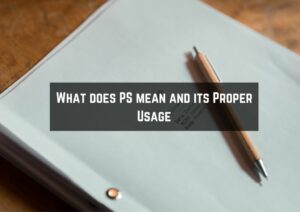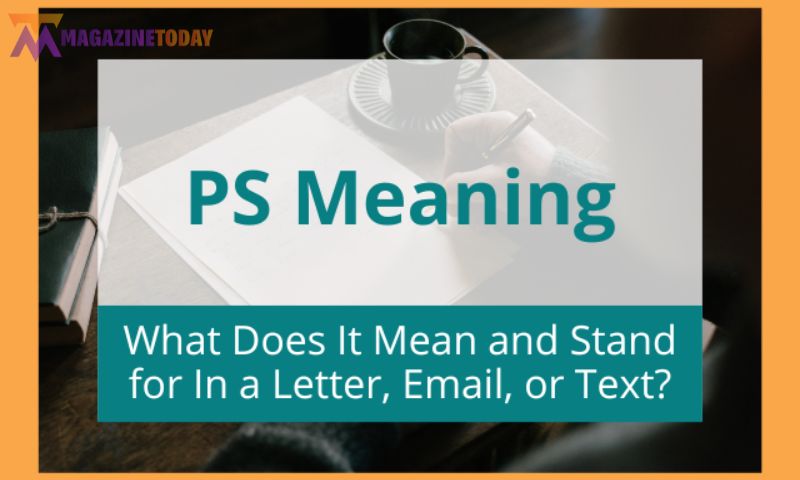Postscript (PS) is a timeless addition to letters, adding charm, personality, and a touch of informality to written communication. Whether you’re crafting a heartfelt personal letter, a professional email, or even marketing material, knowing how to effectively use PS can leave a lasting impression. This guide explores the history, etiquette, and modern applications of PS in a letter.
What Does PS Stand For?


The Meaning of PS
PS stands for Postscript, derived from the Latin term post scriptum, which means “written after.” It is a brief note added at the end of a letter or document after the signature. PS serves as an afterthought or emphasizes an important point without disrupting the structure of the main text.
The Evolution of PS
In the days of handwritten and typewritten correspondence, PS was often used to add forgotten details without rewriting the entire letter. Over time, it became a stylistic tool, adding flair to personal and professional communication.
Why Use PS in a Letter?
Adding a Personal Touch
Including a PS in personal letters allows for a more conversational tone. It can be playful, emotional, or even humorous, making your message more memorable.
Emphasizing Key Points
PS is an excellent way to highlight crucial information. Whether it’s a deadline, an invitation, or an important reminder, placing it in the PS ensures it grabs attention.
Marketing Impact
In the world of marketing, PS is a powerful tool to reinforce calls to action (CTA). Studies show that readers often skim letters and emails, focusing heavily on the PS section for a quick takeaway.
How to Write a PS in a Letter
Placement and Format
The PS comes at the very end of your letter, after your closing signature. It is usually preceded by “PS:” and followed by the message. For multiple postscripts, use “PPS” (Post-Postscript) and “PPPS” for additional notes.
Example:
Sincerely,
[Your Name]
PS: Don’t forget to RSVP by next Friday!
Keep It Short and Sweet
A PS should be concise and impactful. Avoid long, detailed sentences that could have been included in the main body of the letter.
Match the Tone
The tone of your PS should align with the overall tone of your letter. For instance, a professional email may use a formal PS, while a personal letter can include casual or humorous notes.
Examples of PS in Different Letters
Personal Letter Example
Dear Emily,
Thank you for the wonderful dinner last week. I truly enjoyed catching up and hearing about your new project.
Warm regards,
Anna
PS: Let’s plan our weekend hike soon. I’ve found a new trail I think you’ll love!
Professional Email Example
Dear Mr. Carter,
Thank you for considering our proposal. I’ve attached the project outline for your review.
Best regards,
Jane Smith
PS: Please let me know if you need further clarification before Friday’s meeting.
Marketing Email Example
Hi [Customer’s Name],
Thank you for being a valued member of our community! We’re excited to announce our exclusive sale starting tomorrow.
Warm regards,
The XYZ Team
PS: Don’t miss out—use code SAVE20 at checkout for an additional discount.
Common Mistakes to Avoid When Using PS
Overloading the PS Section
A PS should never be a dumping ground for all missed information. Too many details can overwhelm the reader.
Inconsistent Tone
Switching from a formal tone in the letter to a casual or overly friendly PS can confuse or alienate your reader.
Ignoring Grammar and Clarity
Despite its informal nature, a PS should maintain proper grammar and clarity. Sloppy writing can diminish the effectiveness of your message.
PS in the Digital Age
Emails and Newsletters
In modern communication, PS is widely used in emails and newsletters. It serves as a strategic tool to drive home key messages, links, or offers.
Social Media and Texts
Though less common, PS has found its way into social media posts and even text messages, often as a playful or dramatic conclusion to a message.
Creative Uses of PS
Closing a Story
In personal letters, PS can be used to add a surprise or heartfelt touch. For example:
PS: I forgot to mention—I finally got the promotion!
Highlighting CTAs in Marketing
PS: Click here to sign up now and receive a free gift with your order!
Adding Humor
PS: If you bring cake to the meeting, you’ll instantly become everyone’s favorite coworker.
Frequently Asked Questions
1. Is PS still relevant in the digital age?
Yes, PS remains a valuable tool for emphasizing important points, both in personal and professional communication.
2. Can I use emojis in a PS?
In informal contexts, emojis can add a playful touch to your PS. However, they are generally avoided in professional settings.
3. How many PS sections can I include?
While multiple PS sections (PPS, PPPS) are acceptable, it’s best to limit their use to maintain clarity and impact.
4. Can I use PS in text messages?
Yes, but it is less common and typically used for humorous or casual purposes in texts.
5. Should I use bold text for the PS?
In marketing or promotional materials, bolding the PS can draw attention, but it’s not necessary for casual or professional letters.
Final Thoughts
The PS in a letter, while small, is a mighty tool for adding personality, emphasis, and impact. Whether you’re writing a heartfelt note, a professional email, or a promotional message, incorporating a thoughtful PS can elevate your communication. Embrace the charm and utility of the postscript to leave a lasting impression on your readers






